Low Carb Diet For Dogs With Diabetes
Unfortunately, dogs can suffer from a number of the same health problems that people do. One of the most common and serious examples is canine diabetes — a disease characterized by improper pancreas function.
Without a healthy pancreas, your dog will have trouble regulating his blood sugar levels. Left untreated, diabetes can cause very serious complications and even death. So, you'll always want to work with your vet to keep your dog as healthy as possible and feed him a food that provides the kind of nutrition a diabetic dog needs.
- #1 Ketona Chicken Recipe Dog Food [Best Overall Food for Diabetic Dogs]: A specially designed, ketogenic diet designed to help keep blood sugar levels low.
- #2 Yumwoof Perfect Kibble [Best-Tasting Food for Diabetic Dogs]: A great-tasting, low-carb dog food that's slow-cooked and made with human-grade ingredients.
- #3 Instinct Original Wet Dog Food [Lowest Carbohydrate Canned Food for Diabetic Dogs]: A high-protein, low-carb canned option that's great for dogs struggling with diabetes.
What Is Doggie Diabetes?

For the most part, diabetes affects dogs and humans in similar ways.
When food is eaten, it is broken down by the body into its constituent parts — primarily fats, proteins and sugars (glucose). A little while later, the pancreas releases a hormone called insulin; insulin helps the body process the glucose.
However, sometimes the pancreas stops producing insulin or the body's cells fail to respond to it in the proper way. The former problem is referred to as Type I diabetes, while the latter is known as Type II diabetes. Both types are very serious and ultimately manifest in a relatively similar way: The body cannot process glucose properly.
Type I diabetes — the most common form to occur in dogs – is thought to occur when an autoimmune disease attacks the insulin-producing cells in the pancreas. No one knows exactly why this occurs, although there does appear to be a strong genetic link.
Type II diabetes, on the other hand, is often associated with obesity and other factors. Essentially, the body produces so much insulin that the cells become desensitized to the hormone.
In either case, the glucose in the body cannot be used effectively, which can lead to a litany of health problems. Accordingly, diabetes must be considered a very serious condition.
While treatments for both types of diabetes exist, there is no cure – diabetes is a life-long condition.
Diabetes & Your Dog's Diet
Your dog's diet may require some tweaking upon receiving a diagnosis of diabetes.

It will be important to monitor his caloric intake carefully, and many vets will recommend a low-carb, high-fiber food.
Dr. Jeff Werber, chief veterinarian of the Century Veterinary Group in Los Angeles, California, recommends that owners pick a food that has 20 – 25% carbohydrate content on a dry matter basis.
This will help prevent blood sugar spikes, which is imperative when caring for a diabetic pooch. Foods that do not trigger a blood sugar spike are said to have a low glycemic index.
High fiber content also helps in this regard, as it reduces the rate at which glucose is released into the blood stream. It also takes up space in the digestive tract, making your pooch feel full for longer.
There are a few prescription diets made for diabetic dogs, but many diabetic dogs will be fine with a regular, high-quality dog food. You'll need to discuss the issue with your vet to know for sure.
The Best Diabetic Dog Foods
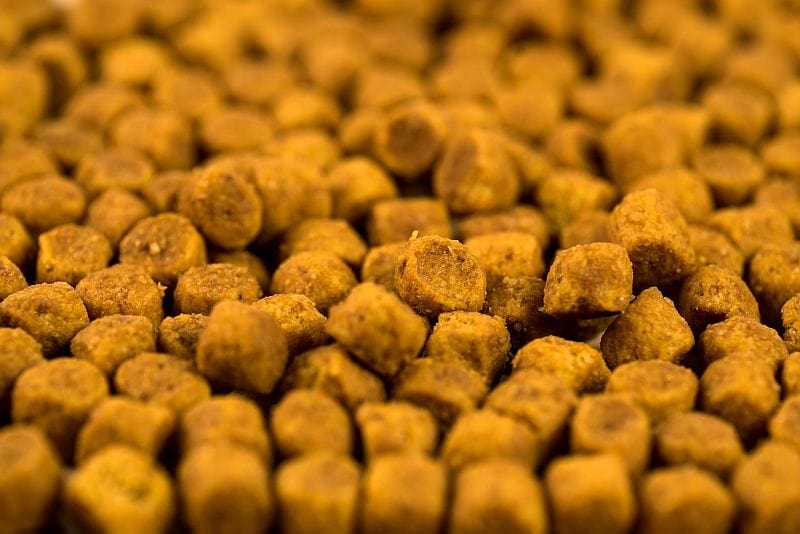
Let's be very clear: Diabetes is a serious medical condition and you must work closely with your vet when selecting a food for your pooch.
However, many owners find it necessary to experiment with different foods until they find one that is not only helpful for regulating their pet's blood sugar levels, but also palatable and easy for their dog to digest.
Accordingly, we present the following foods as some potential options for your diabetic pet.
Each one possesses the general traits that characterize good foods for diabetic dogs, but always discuss any potential dietary changes with your vet and defer to his or her expertise when making a selection.
Also note that some of the foods listed below may not be available without a prescription.
1. Ketona Chicken Recipe Dog Food
About: Ketona Chicken Recipe Dog Food is a scientifically formulated dog food designed to have a very low carbohydrate content.
In fact, this recipe only contains 5% digestible carbohydrate content, 0.5% sugars, and a whopping 46% protein, making it a very intriguing option for diabetic dogs. The only downside is the price — it's quite expensive.
Best Overall Diabetic Dog Food

Ketona Chicken Recipe Dog Food
A specially designed ketogenic dog food made with premium, all-natural ingredients.
Features:
- American-raised, GMO-free chicken is the first listed ingredient
- Contains 46% protein (Guaranteed Analysis)
- Formulated without corn, soy, wheat, or potatoes
- Made in the USA
Ingredients List
Chicken, Pea Protein, Ground Green Peas, Oat Hulls (Source of Fiber), Chicken Fat (Preserved with Mixed Tocopherols)... ,
Flaxseed Meal, Phosphoric Acid, Gelatin, Chicken Liver Digest, Calcium Carbonate, Salt, Pea Fiber, Potassium Chloride, Choline Chloride, Vitamine E Supplement, Niacin Supplement, Thiamine Mononitrate, Calcium Pantothenate, Vitamin A Supplement, Sunflower Oil, Vegetable Oil, Citric Acid (Preservative), Ascorbic Acid, Pyridoxine Hydrochloride, Riboflavin Supplement, Vitamin D3 Supplement, Biotin, Vitamin B12 Supplement, Folic Acid Supplement, Zinc Proteinate, Iron Proteinate, Copper Proteinate, Manganese Proteinate, Iodine Proteinate, Sodium Selenite, Potassium Sorbate (Preservative), Lecithin, Mixed Tocopherols (Preservative), Rosemary Extract.
Pros
- Contains the lowest carb content of any mainstream kibble we've found
- Several owners found it helpful in preventing blood sugar spikes
- Most dogs seem to like the taste
- Great protein content
Cons
- This is a very expensive kibble for a non-prescription option
- Contains no probiotics — this is similar to many others, but given its price, we'd like them included
2. Yumwoof Perfect Kibble
About: Just because your dog is diabetic doesn't mean he has to put up with bad-tasting food! Yumwoof's Perfect Kibble is a slow-cooked food that's not only low in carbs (16% of the food's dry matter), but it's also made with premium ingredients to ensure your diabetic doggo still gets to enjoy dinnertime.
Best-Tasting Option for Diabetic Dogs

Yumwoof Perfect Kibble
A slow-cooked, great-tasting dog food designed by a nutritionist and NYC chef.
Features:
- One of the few shelf-stable foods made with human-grade ingredients
- Features antioxidant-rich "superfoods," including pumpkin and blueberries
- Slow-cooked in a USDA kitchen featuring only US-sourced ingredients
- Contains more MCT (a type of healthy fat) than any other dog food
Ingredients List
Fresh Beef, Eggs, Organic Coconut Oil, Coconut Glycerin, Flaxseed, Carrots... ,
Gluten-Free Oats, Blueberries, Cranberries, Chia Seeds, Seaweed, Beef Liver, Pumpkin, Vitamins and Minerals
Pros
- Slow-cooked for a taste dogs love
- Low carbohydrate content helps prevent blood sugar spikes
- Contains no peas or legumes, which may be correlated with DCM in some dogs
Cons
- Though more affordable than fresh foods, this kind of quality comes at a price
- No probiotics are included, but you can always add Yumwoof's probiotic supplement
- A small number of dogs were initially perplexed by the texture, but most learn to love it
3. Hill's Prescription Diet W/D
About: Hill's Prescription Diet W/D is a prescription dog food that is specifically designed for dogs with digestive difficulties, weight management problems, or blood-sugar issues.
You'll need a prescription from your vet to purchase this food, but that doesn't mean you have to buy it directly from your vet — you can get it from Amazon or Chewy with a prescription from your vet (and often at a better price than your veterinarian offers).
Best Prescription Option for Diabetic Dogs

Hill's Prescription Diet W/D
A prescription dog food designed for dogs with weight or blood sugar issues.
Features:
- High levels of L-carnitine help to speed up your dog's metabolism
- Contains moderate fiber levels to help keep your pup full between meals
- Made in the USA
Ingredients List
Whole grain wheat, whole grain corn, powdered cellulose, chicken meal, corn gluten meal... ,
whole grain sorghum, soybean oil, pork liver flavor, lactic acid, Carmel color, potassium chloride, glyceryl monosterate, chalice chloride, vita E, L-ascorbyl-2, polyphosphate, niacin, thiamine mononitrate, calcium pantothenate, pyridoxine chloride, vitamin A, vitamin B12, Riboflavin supplement, zinc oxide, copper sulfate, manganous oxide, calcium iodate , sodium serenity, turbine, L-carnitine, calcium sulfate, DL-methionine, tryptophan. L-threonine. Mixed tocopherols for freshness. Beta-carotene.
Pros
- Many owners found that this food did exactly what they wanted — it reduced their dog's blood sugar levels
- This food helped some dogs lose weight
- Several dogs digested this food better than some other options
Cons
- No whole is protein included
- Only available with a prescription
- Very expensive, though it's comparable to many other prescription dog foods
4. Orijen Grain-Free
About: Orijen Grain-Free is a highly regarded dog food with very impressive amounts of protein and an extremely low carbohydrate content, making it worthy of serious consideration for diabetic canines.
Best Mainstream Kibble for Diabetic Dogs
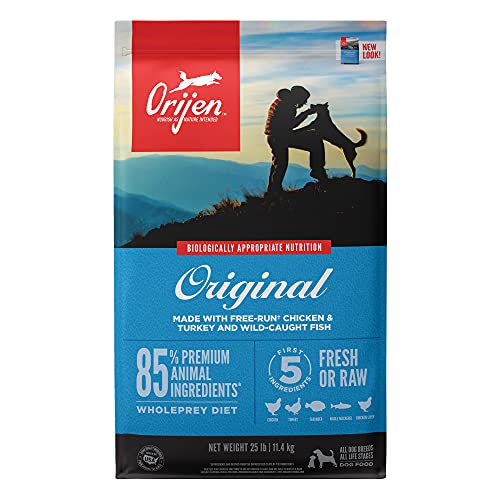
Orijen Grain-Free
A low-carb, protein-rich option that includes organs, cartilage, bones, and probiotics.
Features:
- 20% carbohydrates & 38% protein
- 85% of the content is meat-based; 15% is provided by produce
- Contains no grain, tapioca, or plant protein concentrates.
- Includes fresh meat, organs, cartilage, and bone
- Made in the USA
Ingredients List
Fresh chicken meat (13%), fresh turkey meat (7%), fresh cage-free eggs (7%), fresh chicken liver (6%), fresh whole herring (6%)... ,
fresh whole flounder (5%), fresh turkey liver (5%), fresh chicken necks (4%), fresh chicken heart (4%), fresh turkey heart (4%), chicken (dehydrated, 4%), turkey (dehydrated, 4%), whole mackerel (dehydrated, 4%), whole sardine (dehydrated, 4%), whole herring (dehydrated, 4%), whole red lentils, whole green lentils, whole green peas, lentil fibre, whole chickpeas, whole yellow peas, whole pinto beans, whole navy beans, herring oil (1%), chicken fat (1%), chicken cartilage (1%), chicken liver (freeze-dried), turkey liver (freeze-dried), fresh whole pumpkin, fresh whole butternut squash, fresh whole zucchini, fresh whole parsnips, fresh carrots, fresh whole Red Delicious apples, fresh whole Bartlett pears, fresh kale, fresh spinach, fresh beet greens, fresh turnip greens, brown kelp, whole cranberries, whole blueberries, whole Saskatoon berries, chicory root, turmeric root, milk thistle, burdock root, lavender, marshmallow root, rosehips, enterococcus faecium. ADDITIVES (per kg): Nutritional additives: Zinc chelate: 100 mg.
Pros
- Contains a very low carbohydrate content for a traditional kibble
- Made with several "superfoods" that provide other health benefits
- Formulated with probiotics to support proper digestion
- Contains tons of protein
Cons
- Like many of the other best foods for diabetic dogs, this is a pricey option
- Multi-protein dog foods aren't a great choice for dogs with food allergies
5. Acana Appalachian Ranch
About: Acana Appalachian Ranch is an extremely high-quality, protein-packed dog food with a relatively low carbohydrate content for a mainstream food of just 32% (GA).
Best Protein-Rich Recipe

Acana Appalachian Ranch
A protein-packed dog food made with a variety of deboned meats and meat meals.
Features:
- Deboned beef, deboned pork, deboned lamb, lamb meal, beef meal, pork meal are the first 6 ingredients
- 70% fresh, raw, or dried animal ingredients, along with vegetables, fruits, and botanicals.
- Made in the USA
NOTE: We calculated the carbohydrate percentage using the Guaranteed Analysis data provided by the manufacturer. However, the amount of ash present was not provided. Ultimately, this means that the carbohydrate count may be even lower than what is recored here.
Ingredients List
Deboned beef, deboned pork, deboned lamb, lamb meal, beef meal... ,
pork meal, whole green peas, red lentils, pinto beans, beef liver, beef fat, catfish meal, chickpeas, green lentils, whole yellow peas, deboned bison, whole catfish, herring oil, lentil fiber, natural pork flavor, beef tripe, lamb tripe, lamb liver, pork liver, beef kidney, pork kidney, pork cartilage, dried kelp, whole pumpkin, whole butternut squash, kale, spinach, mustard greens, collard greens, turnip greens, carrots, apples, pears, freeze-dried beef liver, freeze-dried lamb liver, freeze-dried pork liver*, pumpkin seeds, sunflower seeds, zinc proteinate, mixed tocopherols (preservative), chicory root, turmeric, sarsaparilla root, althea root, rosehips, juniper berries, dried Lactobacillus acidophilus fermentation product, dried Bifidobacterium animalis fermentation product, dried Lactobacillus casei fermentation product.
Pros
- This food contains a staggering amount of protein
- The protein-and-produce heavy recipe is great for diabetic dogs
- Contains several "superfoods" that may provide additional health benefits
Cons
- While lower than some other mainstream dog food options, this food contains more carbs than many other options listed here
- It's very expensive
- Multiple proteins may be a problem for dogs with food allergies
- This is a grain-free option, which may present heart health risks
6. Instinct Original Wet Dog Food
About: Instinct Original Grain-Free Canned Food is an extremely low-carb option that may be a good choice for some diabetic dogs.
Lowest Carbohydrate Canned Food for Diabetic Dogs

Instinct Original Wet Dog Food
A grain-free dog dinner with plenty of protein and very few carbohydrates.
Features:
- Made with real beef and venison
- Contains no grains
- 6% estimated carbohydrate content (dry matter basis)
- Made in the USA
Ingredients List
Beef, Venison, Beef Broth, Beef Liver, Ground Flaxseed... ,
Montmorillonite Clay, Peas, Carrots, Potassium Chloride, Minerals (Zinc Proteinate, Iron Proteinate, Copper Proteinate, Manganese Proteinate, Sodium Selenite, Cobalt Proteinate, Potassium Iodide), Menhaden Fish Oil (preserved with Mixed Tocopherols), Salt, Choline Chloride, Vitamins (Vitamin E Supplement, Thiamine Mononitrate, Niacin Supplement, d-Calcium Pantothenate, Pyridoxine Hydrochloride, Riboflavin Supplement, Vitamin A Supplement, Biotin, Vitamin D3 Supplement, Vitamin B12 Supplement, Folic Acid), L-Ascorbyl-2-Polyphosphate, Artichokes, Cranberries, Pumpkin, Tomato, Blueberries, Broccoli, Cabbage, Kale, Parsley
Pros
- This food has the lowest carbohydrate content we could find
- Unlike most other canned foods, this one contains an array of fruits and vegetables
- Protein-rich recipe
Cons
- Contains more fat than most owners like
- Like other canned options, it can be expensive to use this as your dog's primary food
7. Wellness CORE Natural Grain-Free Canned Food
About: Wellness CORE Grain-Free Canned Food is another protein-rich recipe that is also low in carbohydrates.
Made with several different proteins and an assortment of delicious and nutritious fruits and vegetables, this grain-free food may help some owners regulate their dog's blood sugar levels.
Best Premium Canned Option
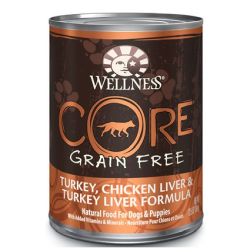
Wellness CORE Natural Grain-Free Canned Food
A grain-free, low-carb canned food that's designed to support metabolic function.
Features:
- Mineral levels specifically formulated to support overall metabolic function
- Made without corn, soy, or wheat
- 50% protein and only 8% carbohydrate content on a dry matter basis
- Made in the USA
Ingredients List
Whitefish, Chicken, Chicken Liver, Salmon Broth, Salmon... ,
Herring, Sweet Potatoes, Ground Flaxseed, Guar Gum, Carrageenan,
Pros
- Contains a very low carbohydrate content
- It is absolutely bursting with protein content
- Most dogs love the taste and digested this food without issue
Cons
- This is an expensive food — even when compared to other canned options
- As always, caution is required when selecting a grain-free food (though the benefits may outweigh the risks for diabetic dogs)
8. Taste of the Wild Southwest Canyon Canned Dog Food
About: Taste of the Wild Southwest Canyon is a low-carb canned food that is bursting with protein (it contains 50% protein on a dry matter basis). In fact, this recipe contains several different proteins, including beef, lamb and wild boar.
Best Multi-Protein Canned Dog Food
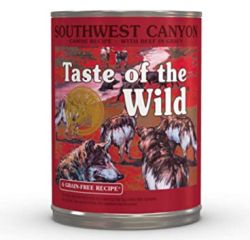
Taste of the Wild Southwest Canyon
A low-carb, multi-protein canned food with antioxidant-rich fruits and veggies.
Features:
- Carbohydrate content of only 20% on a dry matter basis
- Made with antioxidant-rich fruits and vegetables
- Made in the USA
- Appropriate for all life stages
Ingredients List
Beef, beef broth, vegetable broth, beef liver, dried egg product... ,
Peas, potato starch, lamb, wild boar, chickpea flour, guar gum, tricalcium phosphate, natural flavor, sunflower oil, sodium phosphate, salt, potassium chloride, inulin, tomatoes, sweet potatoes, blueberries, raspberries, flaxseed oil (preserved with mixed tocopherols), choline chloride, yucca schidigera extract, fish oil (preserved with mixed tocopherols), zinc amino acid chelate, iron amino acid chelate, vitamin E supplement, copper amino acid chelate, manganese amino acid chelate, sodium selenite, thiamine mononitrate, cobalt amino acid chelate, niacin supplement, d-calcium pantothenate, vitamin A supplement, riboflavin supplement, biotin, vitamin B12 supplement, potassium iodide, pyridoxine hydrochloride, vitamin D3 supplement, folic acid, rosemary extract.
Pros
- Features a low carbohydrate content
- Protein-rich formula
- Relatively affordable for a canned product
- Appeared very palatable to most dogs
Cons
- Contains multiple protein sources; some owners consider this a "pro," but it can be a problem for dogs with food allergies
- A lot of owners reported that the food made their dog very gassy

Important Considerations When Selecting a Diabetic Dog Food
There are a lot of high-fiber, low-fat foods on the market, but that doesn't mean they're all good. In fact, several have very troubling traits that should cause you to look elsewhere.
Look for Products Manufactured in a Country with Rigorous Safety Protocols
Different countries have different food safety guidelines, and this is especially true of pet foods.
To increase your chances of providing your dog with a safe, adulterant-free food, try to pick one manufactured in one of the following countries:
- USA
- Canada
- Australia
- New Zealand
- England
- France
- Germany
Avoid Foods Listing a Carbohydrate as the First Ingredient
Dogs require meat-based diets to look, feel, and act their best, so you always want to use a food that lists a whole protein, such as deboned chicken or fish, as the first ingredient.
Carbohydrates are obviously important components of any dog food, but they should occur farther down the list. Remember, you are ideally looking for a food with a carbohydrate content below 25%.
Not all carbohydrates are created equally either. For example, while there is nothing particularly "wrong" with corn, it isn't the best carbohydrate for dog foods — especially in the case of diabetic dogs. Instead, try to look for foods that utilize carbs like brown rice or bran.
Never Use Foods Containing Unidentified Meat Meals or Byproducts
Although they may seem disgusting to pet owners, meat meals and animal byproducts can be nutritious ingredients.
However, meat meals should not be the first listed ingredient (you still want a whole protein to be the leading ingredient in any food), and they must be properly identified.
For example, chicken byproducts are usually acceptable ingredients; generically labelled animal byproducts are not. Some of these poorly identified meat meals and byproducts may contain protein from very unsavory, and potentially dangerous, sources.
Purchase Foods that Feature all the Nutrients and Supplements Your Dog Needs
Most modern dog foods – particularly premium options – are formulated to contain the proper mix of vitamins and minerals, but health isn't just about vitamins and minerals.
Your dog may need other things in his diet to stay healthy. For example, many good dog foods include antioxidant-rich ingredients, which can help ensure your dog's immune system performs as it should.
Other foods contain supplements like chondroitin or glucosamine, which help protect your dog's joints. Additionally, probiotic supplements are included in many foods to help regulate your dog's digestive system and improve his ability to digest his food.
Avoid Foods with Artificial Additives
Many sub-standard dog foods rely on artificial colors and artificial flavors to help make the food look and taste more appealing.
However, these substances may trigger dog food allergies or other health challenges, and they should be avoided whenever possible. Besides, foods made with high-quality ingredients are typically delicious without these additives.

How to Calculate the Carbohydrate Percentage of Your Dog's Food
Much to the frustration of any owner with a diabetic dog, the carbohydrate percentage is not often displayed on dog food packaging.
Luckily, there is a way you can calculate the amount of carbohydrates in your dog's food using the provided information in the Guaranteed Analysis (GA) section.
- Add up the percentages of protein, fat, moisture, and ash recorded in the GA.
- Subtract that amount from 100.
- That is the percentage of carbohydrates present in the dog food.
One small issue though: the amount of ash isn't usually listed in the Guaranteed Analysis. However, this amount usually ranges from 5% to 8%.
Since we could not get the definitive carb count for some recipes using the GA, the carbohydrate percentage may actually be lower than what we've recorded (we've noted which foods that may be true for below).
In some cases, other sources have provided the carbohydrate percentage; when such data was available, we've used it.
Dog Diabetes Symptoms: Potential Red Flags
Unfortunately, some of the early signs of diabetes are quite subtle and easy to miss. This is yet another reason it is imperative to pay close attention to your dog – he can't tell you when something's wrong, he needs you to spot these symptoms for him.
Some of the most common signs that indicate the possibility of diabetes include the following:
- Increased thirst
- Increase urination
- Appetite changes
- Unexpected weight loss
- Fruity breath
- Unexplained fatigue
- Depression
- Chronic skin or yeast infections
- Urinary tract infections
- Cataracts
These aren't the only dog diabetes symptoms you may notice, but they are among the most common.
If your dog exhibits any of the symptoms discussed above, seek veterinary assistance promptly. Some dogs are already so sick by the time they get to the vet's office that they require hospitalization to stabilize them.
Try to avoid this at all costs to give your pup the best chance of recovering.
How Is Diabetes in Dogs Treated?
Most often, diabetic dogs will require regular blood testing and insulin injections to remain healthy. This will ensure that your dog's blood contains enough insulin to properly process the glucose present.

Don't worry: These procedures are easier than they sound, and your vet will help teach you how to do them safely.
Some dogs can get by with oral medications, which are obviously easier to administer.
Your vet will probably also encourage you to ensure your pup remains active, as exercise can provide important benefits for diabetic dogs.
The amount of exercise you'll need to provide your pet with will vary from one dog to the next. Some may only need regular walks around the neighborhood, while others will require more intense exercise to remain healthy.
Complications of the Early and Final Stages of Diabetes in Dogs
Diabetes is certainly a serious condition, so you'll want to follow your vet's advice very closely to give your dog the best chance of living a long, healthy life.
In fact, if not properly managed, canine diabetes can cause a number of serious health problems or even death. A few of the most important complications of the disease include the following:
- Cataracts — Diabetic dogs often develop cataracts over time, which typically leads to partial or complete blindness. However, cataracts can often be addressed surgically to restore a dog's eyesight.
- Diabetic Retinopathy — This condition occurs when a dog's diabetes triggers changes in the blood vessels that provide blood flow to the eye. In some cases, treatments for this condition are possible.
- Insulin Overdose — If you administer too much insulin to your dog, it can cause his blood sugar levels to plummet, potentially causing a variety of problems, including seizures and permanent brain damage.
- Urinary Tract Infections — Because the urine of diabetic pets often contains high levels of sugar, and some diabetic dogs have difficulty voiding their bladders completely, urinary tract infections are common in diabetic dogs.
Several other complications can also occur in response to your dog's diabetes — particularly if it is not managed well. This includes rear-leg weakness, high blood pressure and low blood calcium levels.
In the final stages of dog diabetes, even more serious problems can occur. This most notably includes diabetic ketoacidosis — a condition in which the body starts using emergency energy stores.
Ketoacidosis can even trigger additional complications, including brain swelling and heart failure.
Dog Diabetes Cost: How Much Will This Illness Set You Back?
Many owners become concerned about the costs involved in treating a diabetic dog once their pup is diagnosed with the illness.
There are a number of different factors that'll influence the amount of money you spend, but we'll try to give you an idea of what to expect below.
Insulin Medications
Most diabetic dogs will require twice-daily insulin injections, although there are (rare) exceptions. Insulin will likely represent the single most expensive component of your dog's treatment on a monthly basis, so you'll want to plan accordingly.
According to PetRx Inc., most owners should expect to pay between $30 and $150 per month on insulin. The exact amount you'll pay will depend on a variety of factors, including:
- The severity of your dog's disease
- The size of your dog (bigger dogs will typically need more insulin)
- Where you obtain the insulin
The last factor is the only one you can really control, but fortunately, it's also the most influential part of the equation. The cost of insulin varies greatly from one vendor to the next, so it is wise to shop around.
For example, many vets will sell insulin to their patients. However, because veterinary clinics are rarely set up to be efficient retail outlets, they usually implement a pretty hefty markup to make the sales worth their efforts.
On the other hand, your local pharmacy will likely have more reasonable prices, as they're very business model is designed around selling medications.
But some of the best prices for insulin can often be found at big-box retailers and their online counterparts (we're talking about Walmart, Costco, Amazon and similar places).
Some of these places even participate in discount programs, which may lower the cost of your dog's insulin even further.
Syringes
Once you've obtained your dog's insulin, you'll need to purchase some syringes to perform the injections.
Syringes aren't terribly expensive, but you'll need to plan to spend about $10 to $20 a month on them.
Try to purchase syringes in bulk whenever possible, as this will usually lower the price-per-unit significantly.
Glucose Monitor, Lancets and Testing Strips
There are a number of different glucose monitors on the market, and they vary significantly in terms of price.
There are cheap models available for around $20, while some of the most expensive cost about $150 or so. You don't want to skimp where your dog's health is concerned, so you should probably expect to spend about $50 in most cases.
Lancets and test strips are disposable supplies that you'll need to use with most glucose monitors.
Like syringes, they aren't terribly expensive, but you will need to set aside money for them on a monthly basis. Typically, dog owners spend about $5 to $20 a month on these supplies.
If you are currently in the market for a glucose monitor, be sure to check out the AlphaTrak 2 Monitoring System Kit.

Designed specifically for cats and dogs, this kit comes with everything you need to get started, including the monitor, lancing device, 30 lancets, 25 testing strips, a carrying case, and two user guides.
Most owners who've tried it found it easy to use and effective. However, some owners complained about the cost of the test strips and lancets sold by the manufacturer of the AlphaTrak 2 kit.
Fortunately, there are more affordable alternatives available, such as this Test Strip and Lancet Kit, sold by Care Touch. These lancets and test strips will work with AlphaTrak and AlphaTrack 2 monitoring kits.
Diabetic Dog Food
Your dog needs food whether he has diabetes or not, but you may find it necessary to purchase a slightly more expensive dog food than normal if your pet is diagnosed with the illness.
Prescription dog foods for diabetes are typically the most expensive options, and some cost twice as much as non-prescription formulas.
However, not all dogs with diabetes require a prescription diet. Your vet may simply recommend switching to a premium dog food, that is high in fiber, low in simple carbohydrates, and full of protein.
In these cases, you'll likely only spend about 10% to 20% more per month on your pet's food. And if you were already feeding your pet a premium brand, you may not have to pay any more for his food at all.
Additional Veterinary Visits
You will likely end up needing to visit the vet several times over a short period of time after your dog is diagnosed with diabetes.
You'll also need to start taking your dog in for more frequent visits so your vet can ensure he is doing well.
The cost of veterinary visits varies, and some vets may be willing to offer reduced rates for patients that must come in repeatedly.
Just ask your vet how much you should prepare to spend on visits, and be sure to inquire about any discount plans he or she offers.
Breeds That May Be Predisposed to Diabetes

Unfortunately, it appears that a few breeds may be more likely to develop diabetes than others. If your dog belongs to one of the following breeds, be extra vigilant about watching for signs of the disease.
- Samoyed
- Keeshonds
- Dachshunds
- Poodles
- Golden
- German Shepherds
- Dobermans
- Schnauzers
- Puli
- Labrador Retrievers
- Cocker Spaniels
- Pomeranians
- Fox Terriers
- Beagles
Additionally, females – particularly overweight individuals — are more likely than males (particularly thin males) to develop diabetes late in life. There is some evidence that suggests spaying may help reduce these risks.
Are Homemade Diets a Good Idea for Diabetic Dogs?
Although an increasing number of owners are experimenting with homemade diets for their pets, we usually discourage owners from doing so.
Properly balancing the nutritional content of a dog food is much more difficult than many dog owners believe it is, and very few owners will be able to prepare a food that is as nutritious as a high-quality commercial food.
Over time, the types of nutritional imbalances that characterize most homemade diets will often result in deficiencies and long-term health problems which are difficult to resolve.
But homemade diets are even more dangerous for diabetic dogs, given their unique dietary needs.
For example, improper carbohydrate and fiber levels may cause your dog's blood sugar levels to swing wildly, which will create an acute threat to your dog's health.
Accordingly, we strongly recommend that owners of dogs with diabetes stick to a good commercial recipe that meets the criteria we discussed above.
Three Final Care Tips for Dogs with Diabetes
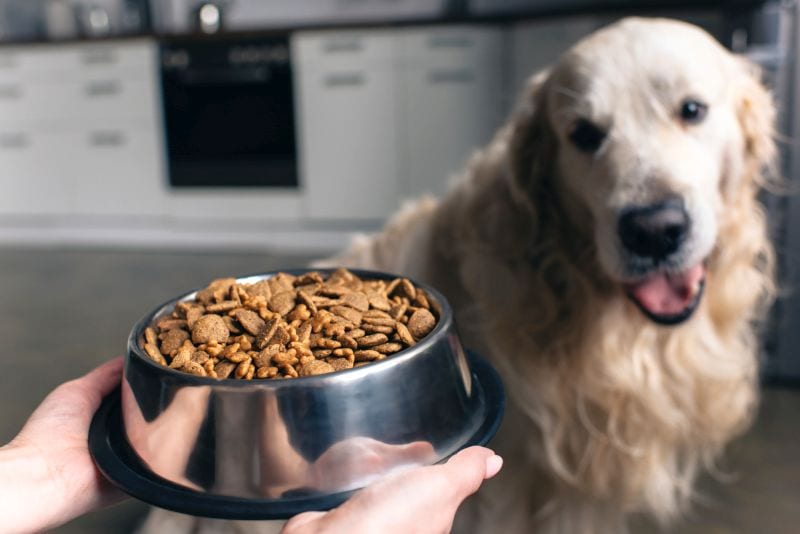
Hopefully, one of the foods listed above will help you manage your dog's diabetes and ensure that he enjoys many more years to come.
But before you go, we wanted to share three more tips, which should help your dog whether he is in the early or final stages of dog diabetes.
1. Feed Your Dog on a Regular Schedule
In addition to providing your dog with a low-carb, high-fiber food, it is also important to feed your dog on a consistent schedule. This will also help to keep his blood glucose levels stable.
You'll need to discuss the optimal feeding schedule with your vet, but most diabetic dogs will thrive on a twice-daily feeding schedule. Typically, you'll want to feed your dog right before administering his insulin.
No matter what feeding schedule you and your vet decide upon, try your best to feed your dog at the same times each day.
2. Don't Switch Foods Unnecessarily
Unless there's a compelling reason to do so, try to avoid making significant changes to your diabetic dog's diet.
Switching foods can cause your pet's blood sugar levels to fluctuate in unpredictable ways, which can put his health in jeopardy.
Accordingly, you'll want to think carefully about the food you select, and always talk to your vet before changing to a different recipe or brand.
3. Don't Forget to Think About Treats
Treats can represent a significant portion of your dog's daily calories, so be sure that you don't sabotage your efforts to keep your dog's blood glucose levels under control by giving your diabetic pup high-calorie or sugary treats.

You can still give your pet treats (assuming your vet signs off on the practice), but just be sure to limit them and to select treats that are protein-based!
For example,Old Dog Cookie Co. manufacturers treats made specifically for diabetic dogs.
These American-made, certified-organic treats are made with several ingredients that will help to manage your dog's blood sugar levels, and most dogs appear to love the way they taste too!
***
Do you have a diabetic dog in your care? What types of foods have you found helpful? We'd love to hear all about it (particularly if you are aware of a great food we missed) in the comments below.
Low Carb Diet For Dogs With Diabetes
Source: https://www.k9ofmine.com/best-foods-for-diabetic-dogs/








Tidak ada komentar:
Posting Komentar